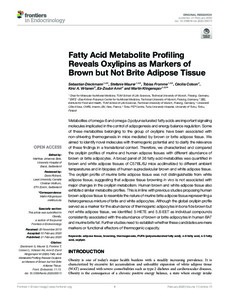Fatty Acid Metabolite Profiling Reveals Oxylipins as Markers of Brown but Not Brite Adipose Tissue
Sebastian Dieckmann; Stefanie Maurer; Tobias Fromme; Cécilia Colson; Kirsi A. Virtanen; Ez-Zoubir Amri; Martin Klingenspor
Fatty Acid Metabolite Profiling Reveals Oxylipins as Markers of Brown but Not Brite Adipose Tissue
Sebastian Dieckmann
Stefanie Maurer
Tobias Fromme
Cécilia Colson
Kirsi A. Virtanen
Ez-Zoubir Amri
Martin Klingenspor
FRONTIERS MEDIA SA
Julkaisun pysyvä osoite on:
https://urn.fi/URN:NBN:fi-fe2021042822182
https://urn.fi/URN:NBN:fi-fe2021042822182
Tiivistelmä
Metabolites of omega-6 and omega-3 polyunsaturated fatty acids are important signaling molecules implicated in the control of adipogenesis and energy balance regulation. Some of these metabolites belonging to the group of oxylipins have been associated with non-shivering thermogenesis in mice mediated by brown or brite adipose tissue. We aimed to identify novel molecules with thermogenic potential and to clarify the relevance of these findings in a translational context. Therefore, we characterized and compared the oxylipin profiles of murine and human adipose tissues with different abundance of brown or brite adipocytes. A broad panel of 36 fatty acid metabolites was quantified in brown and white adipose tissues of C57BL/6J mice acclimatized to different ambient temperatures and in biopsies of human supraclavicular brown and white adipose tissue. The oxylipin profile of murine brite adipose tissue was not distinguishable from white adipose tissue, suggesting that adipose tissue browning in vivo is not associated with major changes in the oxylipin metabolism. Human brown and white adipose tissue also exhibited similar metabolite profiles. This is in line with previous studies proposing human brown adipose tissue to resemble the nature of murine brite adipose tissue representing a heterogeneous mixture of brite and white adipocytes. Although the global oxylipin profile served as a marker for the abundance of thermogenic adipocytes in bona fide brown but not white adipose tissue, we identified 5-HETE and 5,6-EET as individual compounds consistently associated with the abundance of brown or brite adipocytes in human BAT and murine brite fat. Further studies need to establish whether these candidates are mere markers or functional effectors of thermogenic capacity.
Kokoelmat
- Rinnakkaistallenteet [27094]
